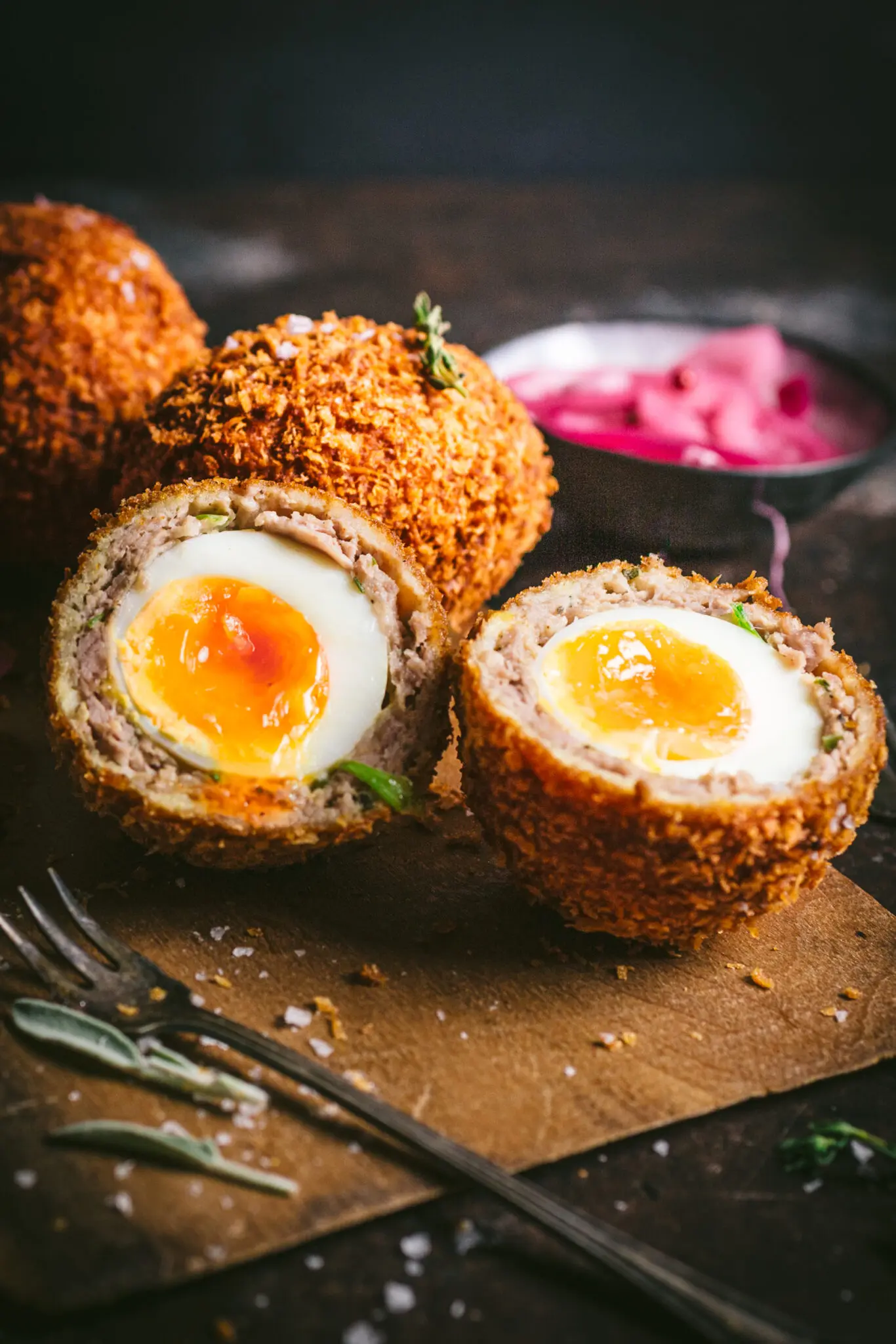
Every country and cuisine has its convenience food: the dish that’s so ubiquitous – it’s in the supermarket, the corner store, the petrol station – why would you ever bother making it yourself? For Britain, I think that food is the Scotch egg. A soft-boiled egg wrapped in layers of sausage meat and breadcrumbs and deep fried. (The egg is, frequently, found hard-boiled: let’s talk about that below)
All the component parts sound like they should fit together beautifully, and indeed they do – if your recipe is good. Too often, something goes wrong. The egg is overcooked and ends up with a chalky or green-ringed yolk, the pork is insufficiently seasoned and bland, the crumb coat is soggy. It’s easy to throw up your hands and say, well, what can you do, it’s just a Scotch egg. And then we had a quail’s egg version at our favorite restaurant in Wales, Llys Meddyg, and here’s what happened to our minds.
Yes, our minds were blown.
OK, admittedly, we were on our honeymoon, and we had had a good amount of whisky at that point. However, this was genuinely a turning point in our appreciation of the humble Scotch egg. The outside was beautifully crispy, to the point where you could almost crack it with a knife. The pork was rich and tasty – I wouldn’t be surprised if it was mixed with a little black pudding. And the egg was warm and gooey and – did I mention? – was of the teeny tiny quail persuasion. So yeah, that was a bit of magic on a plate.
Admittedly, I haven’t eaten a “native” Scotch egg in years, so I wanted to refresh my memory of what kind of quality item you might find packaged in the chilled goods section of your local Tesco Metro. So I asked my Mum.
This is what she said, verbatim. “You go to the shop, and you’re peckish and think, ooh, I really fancy one of those, so you take it home and have one bite, and then you say to yourself I really wish I hadn’t bought this, it’s absolutely disgusting. That’s horrible.”
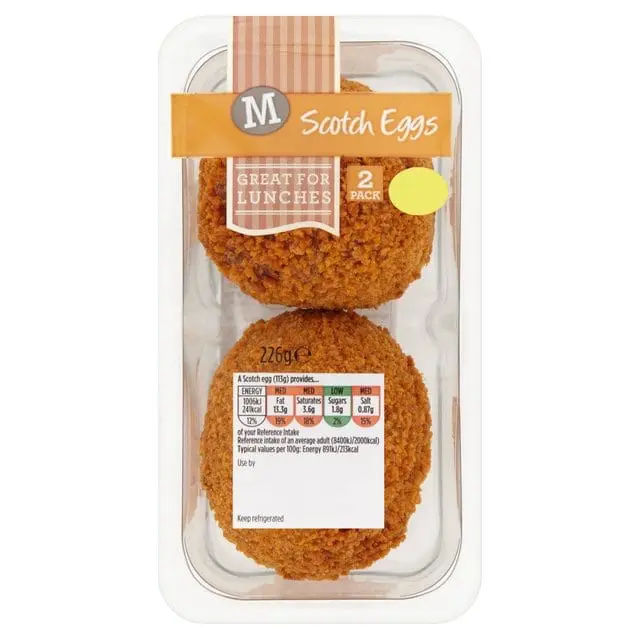


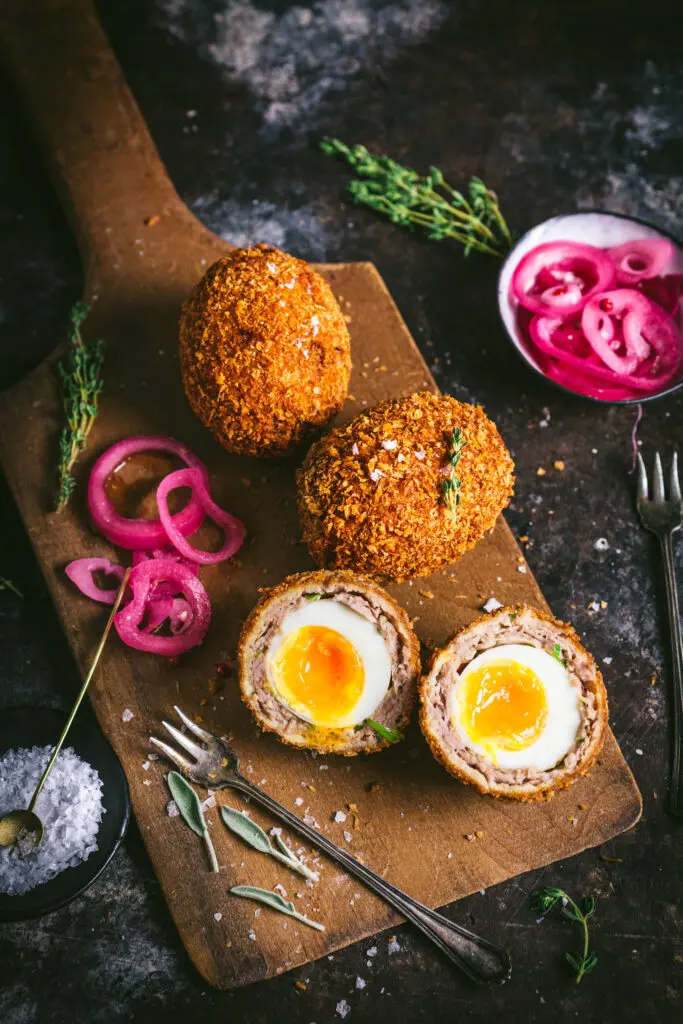
I don’t know why we had never got around to making our own. It’s not like we’re ever short of eggs.
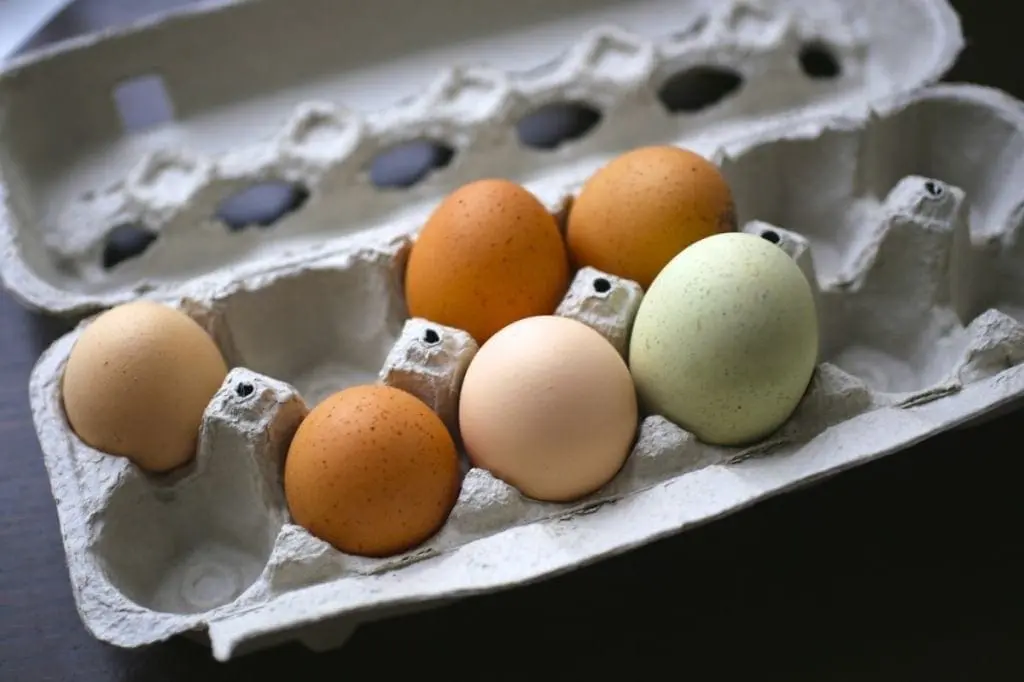
Cooking the Eggs Perfectly
Onto the recipe. Here’s how we approached these beauties. First, we wanted to make sure we cooked the eggs perfectly. We started with extra-large eggs placed in a pot with cold water to cover by an inch. Once the water boiled, we dropped the heat to low and simmered them for exactly four minutes. At that point, we immediately removed them into an ice bath and let them sit until they were cool: a good 10-15 minutes. Then we gently peeled them. (This can be done up to a day ahead).
(TIP: Older eggs will be easier to peel than younger eggs since they develop an air pocket between the shell and the white, so if you have a choice of eggs, go with the older ones for this recipe.)
Seasoning Choices
Most recipes for Scotch Eggs call for an all-sausage wrap but we found that can make the eggs a little greasy so we went with a mix of breakfast sausage (taken out of its casing) and ground pork. Ground pork is leaner and a little more coarse, so the combination is just perfect.
The meat is then seasoned with mustard, as well as a mix of fresh herbs (you can use whatever you like but we went with chives, thyme, sage and parsley). We also like to add a little freshly ground nutmeg – this adds a really nice warmth to the mix. Combine the meat and seasonings well, then divide it into 8 balls. You can put them in the fridge while you prepare the coatings.
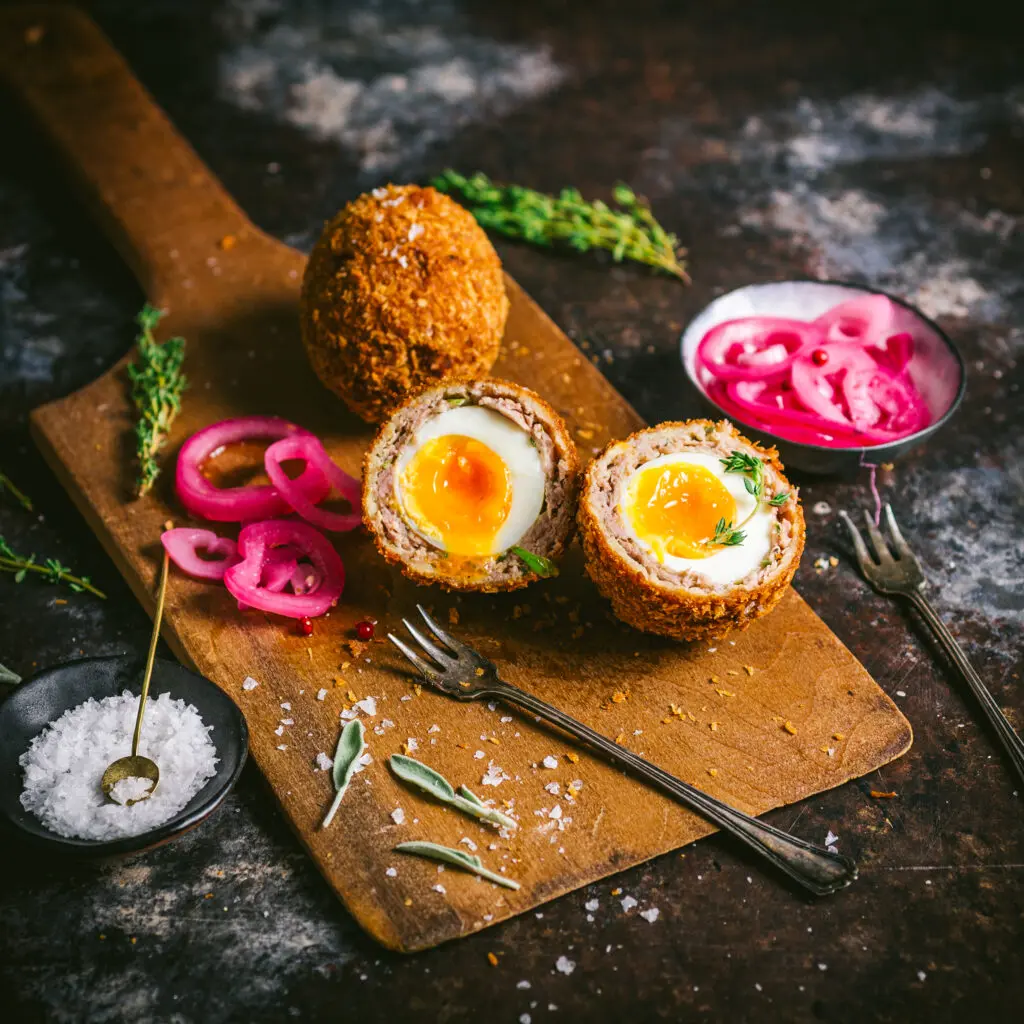
Preparing Everything
You’ll need three shallow bowls for your coatings: seasoned flour, egg (with a little milk), and breadcrumbs. We use panko for almost every recipe that calls for breadcrumbs since we love the coarse texture and crispness of the resulting coating. If you prefer to use regular breadcrumbs, we recommend you look for unseasoned (i.e., without any dried herb flavors).
Once the eggs are peeled and the pork is ready, it’s time for them to combine forces. Take one pork ball and gently flatten it between two approx. 8″ pieces of cling wrap. You can use your hands or a roller. You’ll want to end up with a shape large enough to cover the egg, so it should be 1/4 to 1/2″ thick (and as even as you can get it without too much stress). Once it’s ready, peel off the top layer of cling wrap.
Roll an egg in flour and place it in the center of the sausage, and lift up the cling wrap to roll the meat layer around the egg evenly, closing up the gaps with your fingers. You can use damp hands to coax it into a smooth egg shape.
Next, roll the covered egg in flour, shake off any excess, and dip in the egg/milk mixture to coat thoroughly, dip into the breadcrumbs to coat, and then give it one more round of egg/milk and breadcrumbs. YES TWO LAYERS OF BREADCRUMBS! This is vital and should not be skipped if you want really crunchy, crispy Scotch Eggs.
Shake off any loose crumbs and set all your coated eggs on a tray. Have another tray with a cooling rack set atop it – this is for the fried Scotch eggs to catch any oil drips.
Get Ready to Fry
Prepare a deep fat fryer or a medium-large (3-quart) pot with neutral cooking oil, filled with at least 3 inches of oil (but make sure not to fill it more than halfway). Heat the oil to 350ºF/175ºc. Carefully lower in two eggs, one at a time (don’t crowd the pot – you don’t want the temperature to drop too much). Fry for 5 – 7 minutes, turning them gently in the oil every so often (we found 6 minutes was perfect). When the eggs are a deep golden brown and have mostly stopped bubbling, remove them with a spider or slotted spoon and place them onto the cooling rack. Check the oil temperature before you add the next batch – make sure it returns to 350ºF.
Scotch Eggs can be eaten hot, warm or room temperature. (Keep any uneaten eggs refrigerated and they should last 4-5 days.) We like to serve them with a good sprinkle of flaky sea salt (our favorite is Maldon) and some Quick-Pickled Red Onions.
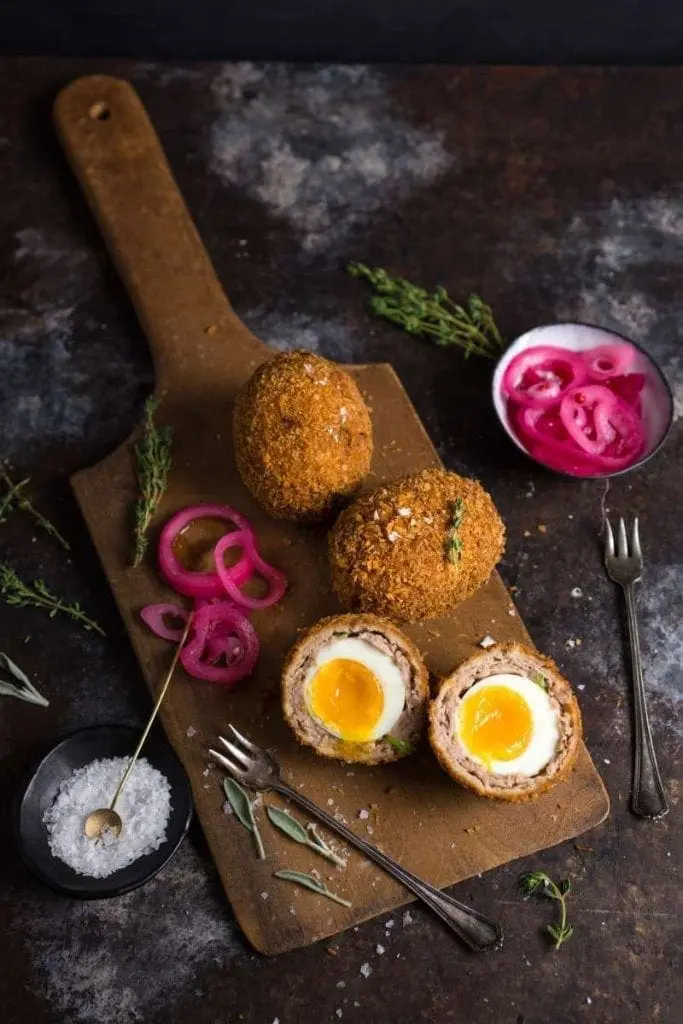
Slice in half and marvel at the perfect runny yolks! This is exactly what we were after, not so liquid that they run everywhere, but gently oozing, with an almost pudding-like softness.
These Scotch eggs should stay runny even a few days later. You will be the hero of your next picnic! Well, to be honest it’ll be between you and the guy who individually punches wasps in the nose. I love that guy.
 [/wd_hustle]
[/wd_hustle]Scotch Eggs with a Perfect Runny Yolk
Ingredients
- 10 eggs, extra large (Makes 8 Scotch eggs and you'll use 2 for the coating)
- 1 lb. pork breakfast sausage , raw, removed from casing
- 3/4 lb. ground pork
- 1/4 cup chopped mixed herbs chives, sage, parsley and thyme
- 1/4 teaspoon freshly ground nutmeg
- 1 tablespoon Dijon mustard
- Coarse kosher salt and freshly ground pepper
- 1 tablespoon whole milk
- 6 tablespoons all-purpose flour
- 2 cups panko breadcrumbs
- 1 quart Vegetable oil
- Coarse sea salt optional
Instructions
- Put 8 eggs into a saucepan, cover with cold water (an inch above the eggs) and bring to the boil over medium-high heat. As soon as it boils, turn heat to low and simmer for four minutes, then transfer eggs into a large bowl of ice water for at least 10 minutes. Peel the eggs.
- Add the sausage, ground pork, herbs, nutmeg and mustard to a medium bowl, season with a pinch of salt and pepper. Mix well with your hands to combine. Divide into 8 balls.
- In a shallow bowl, beat the two raw eggs with a tablespoon of milk. In a second shallow bowl, add the flour and season with a good pinch of salt and pepper. Add the breadcrumbs to a third bowl. Arrange in an assembly line in the order of flour, egg, breadcrumbs.
- Cut a square of plastic wrap, place on worksurface, and put one of the meatballs in the middle, then place another square of plastic wrap on top. Roll out or press the meat until large enough to cover the egg. Repeat process with the other balls. When ready to use, remove the top sheet of plastic wrap.
- Roll one peeled egg in flour, then place in the center of the meat. Bring up the sides of the film to encase it, and smooth it into an egg shape using damp hands. Dip each covered egg in flour, then egg, then breadcrumbs, then egg and then breadcrumbs. Repeat with all eggs.
- Fill a heavy-bottomed 3-quart pot a third full of vegetable oil (at least 3 inches deep), and, on medium-high heat, bring to 350º / 175ºC (if you don’t have a thermometer, check for when a few bread crumbs sizzle and turn golden, but do not burn, a few seconds after you drop them in). Fry the eggs two at a time, turning gently in the oil, for 5-7 minutes, until crispy and golden brown. Remove to a rack set over a sheet tray. Sprinkle over coarse sea salt while still hot. Serve with Quick-pickled red onions, if desired.
Nutrition
 [/wd_hustle]
[/wd_hustle]

I’ve been looking for a good explanation for how to make these! Beautiful post! I’ll let you know how they come out once I make them.
Best recipe I’ve found for these. They came out perfect and hubby was truly amazed. The tips and personal adjustments you’ve made to the standard recipe brought these to the next level. Umami-madness! Thank you for sharing!
Awesome! So glad they worked well for you. We’re obsessed with them on our house 🙂
Please can someone help I have tried theses 4 times and still don’t get a runny yolk
Hi Aimee
I’m sorry you’ve had trouble! I wonder if your eggs are a little bit smaller than the ones we used. Try stepping the simmer time down to 3 and a half minutes. Let us know if that helps!
Did you use the extra large eggs as instructed?
you could always freeze the eggs first to help keep them from being over cooked…freeze the egg in shell and then peeling the shell off while frozen is easy and then do the standard dipping and coating like instructed above
4.5
What a lovely post! Can’t wait to make these for our family Christmas dinner! I wonder, why go for extra large eggs instead of smaller ones or as you said, quail eggs? Wouldn’t smaller eggs be easier to work with? Just wondering! 🙂 X
Hi Josephine! You can absolutely do it with any size eggs, but the trick is in the timing. Our goal was to keep the egg yolks a little gooey while the pork coating is being fully cooked. If you reduce the egg size, also reduce the size of the meat layer and pull them out of the oil a little sooner – experiment and find what works for you! Let us know how you get on.
5
5
5
5
5
Fantastic just made a couple useing Clonakilty black pudding and sausage mix with your instructions, wish I could post a picture for you – you said they’d last 4 days well about 4 mins when my husband saw them !
Do you use seasoned panko or plain? I plan on making these Sunday with oven baked home fries! Thank you!
Hi Katie, We always use plain panko. There’s plenty of seasoning in the breakfast sausages! Hope you like them 🙂
5
5
Did you explain why you make them soft? EVERY place I’ve had them, they were hard boiled.
We just like them soft! The hard-boiled versions are more common – they’re much easier to make, for one thing, but they’re also easy to over-cook, so you often end up with an unappealing center (often with that green ring).
I’m all in on the soft yolk. The sausage and breading now have an amazing sauce. Timing is everything for sure thanks for your recipe.
If you had them hard boiled, it’s just cooks who don’t know what the correct way is to make them.
As a Scottish person I can assure you that you couldn’t be more wrong. Although this is a very good alternative version of a scotch egg, traditionally the egg is not runny at all. That said, don’t get me wrong, I rather enjoyed this version.
There is a small business who sell really nice ones on farmers markets in the north east. So i thought I would try and make some equaly as good, after searching through Google etc. I found your recipe I followed your instructions but added haggis to the sausage mix and made my own breadcrumbs, I have to say these are the best scotch eggs I have ever had. The only comment I have is you say they will last 4 days in the fridge unfortunately I wouldn’t know because they never made it to the fridge. So thank you.
Thanks Michael! I WISH we could get good haggis locally, although I’m sure we can order it online from somewhere these days. It sounds delicious and I’m so happy you liked them!
I definitely want to try this! Any thoughts on whether I can use an air fryer or an oven instead of a deep fryer?
Hi Aerin! We don’t recommend using an oven, since you’re not going to get a crispy exterior and for us, that’s a big part of the appeal. However, an air fryer might be a good method. We haven’t tried it ourselves but at some point we’ll dig out the fryer and have a go. If you wanted to try it and let us know what your results were, we’d love to hear all about it!
Clear recipe but with large or medium eggs cooking them using above method resulted in hard boiled eggs!
Instead, I plunged eggs at room temperature into boiling water and cooked for 5” then plunged into ice cold water.
This resulted in runny eggs which are difficult to peel but at least you know the yolk is runny!
After deep fat frying till golden brown (about 4”), I finished off in oven at 180C for 6” to finish cooking sausage meat.
Perfectly runny eggs!
That’s a great technique, Malcolm – thanks for the tip!
Thank you for this excellent recipe. This was our first time making scotch eggs and they were perfect.
Since we used large eggs straight out of the fridge we added them to the water after it was boiling and cooked them for 6 minutes before going straight into the water bath. They were beautifully soft boiled.
Seasonings were just right and the blend of breakfast sausage and pork kept it from getting too greasy. The panko made the coating light and crispy. We will definitely make these again!
This has been our go to Scotch Egg Recipe for nearly a year now! My husband and I make this at least once a month with our air fryer. It took some trial and error to retain the runny yolk with the air fryer but we have it down now. We use our air fryer to soft boil the eggs for 10 minutes, do all the steps, and then cook the eggs in the air fryer at 350 degrees for 20 minutes to keep the runny yolk!
Thank you so much for this recipe! Our friends and families love this dish as well!
I really wanted those yolks runny and I think the key to that is the 10 minute ice bath. My biggest challenge was keeping the sausage from unzipping while in the fry but for a first attempt I’m thrilled. thanks guys!
no fail soft boiled eggs. put eggs in pan cover with water. as soon as it starts to boil time them for 3 minutes. drain water and let sit in cool water. always comes out perfect.
I love these! I am going to make them again for a guy’s trip that my buddies and are taking, I am wondering though, can I make them the day before and then just reheat them in an oven? Will they still taste okay that way?
Hi Luke, yes, they reheat well (though traditionally, they are usually eaten at room temperature). Put them in a low oven (around 225-250ºF) for about 10 minutes or so, depending on how bug they are and how hot you want them. Enjoy your trip!
I always wanted to try to make Scotch eggs, but was always intimidated because it is a fairly technical recipe to get right. This recipe is explained well and precise which resulted in a recipe I am willing to make over and over.
This was frustrating. I couldn’t get my eggs to soft boil correctly. I ended up throwing everything in the trash. What a shame.
Sorry to hear that, Diana. Can you describe the problem? Maybe we can help you troubleshoot.
I can’t find a “Pin” button to add this to my Pinterest account. Am I missing it somewhere?
Tried this recipe over the weekend and was really pleased with the results. Trying to get the shell off without damaging the egg was a bit of a faff. The egg was soft but not runny which was probably due to my timing. Son-in-law, granddaughter and her husband have asked to get half of one on a bed of black pudding as a starter at Christmas !!
I think this is a fantastic recipe !! a soft-boiled egg is not hard to make it is supposed to have a runny center..perfect recipe perfect instructions great job !! I love these and so don’t the people in the restaurant industry …thank you so much ! .. I don’t understand how you could fail on a soft-boiled egg ..actually kind of amusing.
5 All the way..
Hi, This looks lovely. How do you prevent the sausage end coating from cracking?
Hi Saira, we haven’t had issues with the sausage or coating cracking. If you’re having that issue, I might recommend chilling the coated eggs before frying. Maybe just for 20 minutes or so and see if that helps.
One clarification needed, are your eggs out of the fridge or room temperature when you boil them. It will obviously make a difference with the cooking time.
I made these but did the eggs in my instant pot for 3 minutes. They had a perfect runny yolk and the shells just slid right off. I’m wondering if anyone has tried freezing them? How did you reheat and how did the yolks turn out?
I found the recipe to be a fine spring board for us to fine tune. For us we discovered double coating with panko on top of 3.5 oz of meat per egg just made these too huge for us and the egg got lost. 2.25 oz and a single coating of seasoned bread crumbs were to our liking.